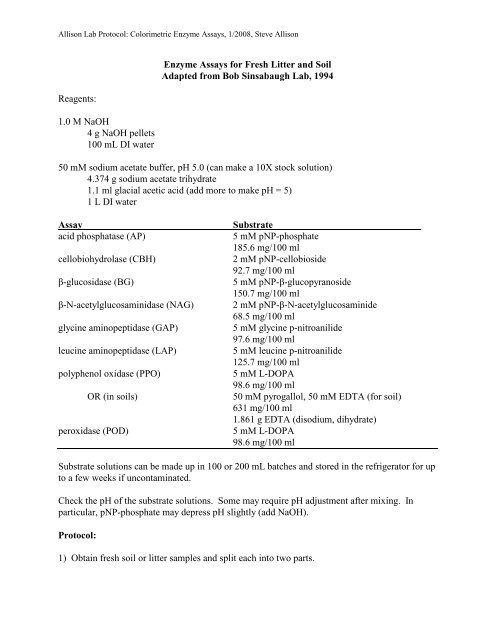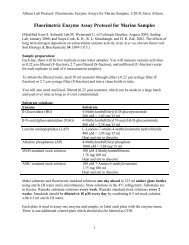Colorimetric Enzyme Assays - The Allison Lab
Colorimetric Enzyme Assays - The Allison Lab
Colorimetric Enzyme Assays - The Allison Lab
Create successful ePaper yourself
Turn your PDF publications into a flip-book with our unique Google optimized e-Paper software.
<strong>Allison</strong> <strong>Lab</strong> Protocol: <strong>Colorimetric</strong> <strong>Enzyme</strong> <strong>Assays</strong>, 1/2008, Steve <strong>Allison</strong><br />
Reagents:<br />
1.0 M NaOH<br />
4 g NaOH pellets<br />
100 mL DI water<br />
<strong>Enzyme</strong> <strong>Assays</strong> for Fresh Litter and Soil<br />
Adapted from Bob Sinsabaugh <strong>Lab</strong>, 1994<br />
50 mM sodium acetate buffer, pH 5.0 (can make a 10X stock solution)<br />
4.374 g sodium acetate trihydrate<br />
1.1 ml glacial acetic acid (add more to make pH = 5)<br />
1 L DI water<br />
Assay Substrate<br />
acid phosphatase (AP) 5 mM pNP-phosphate<br />
185.6 mg/100 ml<br />
cellobiohydrolase (CBH) 2 mM pNP-cellobioside<br />
92.7 mg/100 ml<br />
β-glucosidase (BG) 5 mM pNP-β-glucopyranoside<br />
150.7 mg/100 ml<br />
β-N-acetylglucosaminidase (NAG) 2 mM pNP-β-N-acetylglucosaminide<br />
68.5 mg/100 ml<br />
glycine aminopeptidase (GAP) 5 mM glycine p-nitroanilide<br />
97.6 mg/100 ml<br />
leucine aminopeptidase (LAP) 5 mM leucine p-nitroanilide<br />
125.7 mg/100 ml<br />
polyphenol oxidase (PPO) 5 mM L-DOPA<br />
98.6 mg/100 ml<br />
OR (in soils) 50 mM pyrogallol, 50 mM EDTA (for soil)<br />
631 mg/100 ml<br />
1.861 g EDTA (disodium, dihydrate)<br />
peroxidase (POD) 5 mM L-DOPA<br />
98.6 mg/100 ml<br />
Substrate solutions can be made up in 100 or 200 mL batches and stored in the refrigerator for up<br />
to a few weeks if uncontaminated.<br />
Check the pH of the substrate solutions. Some may require pH adjustment after mixing. In<br />
particular, pNP-phosphate may depress pH slightly (add NaOH).<br />
Protocol:<br />
1) Obtain fresh soil or litter samples and split each into two parts.
2) Weigh one part, record mass, place in tared coin envelope or soil tin and dry at 60-105°C to<br />
constant weight (2 days). Record dry mass.<br />
3) Weigh other part (1-2 g wet weight), record mass, and place in blender Mini-Jar. Add 60 ml<br />
acetate buffer and blend on highest speed for 2 minutes. Pour homogenate into labeled bottle.<br />
4) Choose a microplate configuration. Use 6-8 replicates for all assays and controls. Each plate<br />
needs a set of wells for blanks (empty wells or 200 µL buffer only) and the substrate control<br />
(substrate+buffer). Each sample needs a set of wells for homogenate controls<br />
(homgenate+buffer) and the actual assay (homogenate+substrate).<br />
5) Pour the homogenate into a petri dish or shallow container with a magnetic stir bar and stir<br />
vigorously. Be sure homogenates stay well mixed as you pipet homogenate into the wells. To<br />
prevent clogging of the pipet tips, snip off the ends to make an opening 1-2 mm in diameter.<br />
6) Using the multichannel pipetter, add 50 µL homogenate to the homogenate control and assay<br />
wells. Add 50 µL buffer to the substrate control wells. Add 150 µL buffer to the homogenate<br />
control wells. Add 150 µL substrate to the substrate control and assay wells. For the peroxidase<br />
assay, add 10 µL 0.3% H2O2 to the substrate control and assay wells.<br />
7) Place plates on a shaker. Oxidase assay plates should be shaken as rapidly as possible without<br />
spillage. Incubate AP assay for 45 min, PPO for 1-2 h, NAG for 3 h, CBH for 4 h, BG for 1-2 h,<br />
and peptidases for 4-6 h. Times can be varied based on the amount of activity in the sample.<br />
8) Soil particles will sink to the bottom of the wells during the incubation. Using the<br />
multichannel pipetter, remove 100 µL from the wells, being careful not to suck up the soil on the<br />
bottom, and place in new microplate (tip: you can orient the pipetter so you don’t have to change<br />
tips as often). Skip to (12) for PPO assay, and (14) for the peptidase reactions.<br />
9) Add 5 µL 1.0 M NaOH to all wells to terminate the reaction and develop the color.<br />
10) Read absorbance at 405 nm. In general, if sample absorbances exceed 2.000 the assay<br />
should be repeated using a shorter incubation time or less homogenate.<br />
11) Activity is expressed in µmol of substrate hydrolyzed per hour per g dry organic matter as<br />
follows:<br />
OD = Sample Abs – (Substrate control Abs + Sample control Abs)<br />
Activity (µmol h -1 gDOM -1 ) =<br />
OD/ [(EC/µmol/ml)/(0.200 mL/assay) (incubation, hr) (gDOM/mL sample homogenate)<br />
(0.050 mL homogenate/assay)]<br />
gDOM = (g wet litter mass) (oven dry mass/wet litter mass)
<strong>Allison</strong> <strong>Lab</strong> Protocol: <strong>Colorimetric</strong> <strong>Enzyme</strong> <strong>Assays</strong>, 1/2008, Steve <strong>Allison</strong><br />
NOTE: <strong>The</strong> micromolar extinction coefficient for p-nitrophenol is ~4.2 under the conditions of<br />
this assay. To calculate, run a standard curve by making dilutions of a 1.00 µmol/mL solution of<br />
p-nitrophenol in buffer. Add 100 µL of each concentration and 5 µL 1 M NaOH to the wells and<br />
read absorbances. Do a linear regression of OD vs. concentration. <strong>The</strong> slope of the line is the<br />
extinction coefficient. Absorbance is linear with concentration up to an OD of about 2.000.<br />
------------------------------------------------------PPO/POD---------------------------------------------------<br />
12) Measure the absorbance of the supernatant at 405 nm (Pyrogallol) or 450 nm (L-DOPA).<br />
13) Compute activity as µmol substrate converted per hour per g dry organic matter of sample as<br />
follows:<br />
OD = Sample Abs – (Substrate control Abs + Sample control Abs)<br />
Activity (µmol h -1 gDOM -1 ) =<br />
OD/ [(EC/µmol/ml)/(0.200 ml/assay) (incubation, hr) (gDOM/ml sample homogenate)<br />
(0.050 ml homogenate/assay)]<br />
Peroxidase activity is the difference in activity between the PPO and the peroxidase assay<br />
samples.<br />
NOTE: To determine the extinction coefficient, I used a reaction mixture of 100 μl mushroom<br />
tyrosinase (1 mg/ml in 50 mM acetate buffer, pH 5.0), 3 ml acetate buffer, and 1 ml of 1 mM L-<br />
DOPA or pyrogallol in acetate buffer. <strong>The</strong> absorbance at 450 nm (L-DOPA) or 410 nm<br />
(pyrogallol) maxes out after about 6 hours at room temperature. Measure the absorbance of 100<br />
µL aliquots of the reaction mixture after it maxes out, and divide by 0.25 μmol/ml to get<br />
absorbance/(μmol/ml). I got a micromolar extinction coefficient around 0.403.<br />
--------------------------------------------------Peptidases-----------------------------------------------------<br />
14) Measure the absorbance at 405 nm.<br />
15) Compute activity as µmol substrate converted per hour per g dry organic matter of sample as<br />
follows:<br />
OD = Sample Abs – (Substrate control Abs + Sample control Abs)<br />
Activity (µmol h -1 gDOM -1 ) =<br />
OD/ [(EC/µmol/ml)/(0.200 ml/assay) (incubation, hr) (gDOM/ml sample homogenate)<br />
(0.050 ml homogenate/assay)]<br />
NOTE: <strong>The</strong> micromolar extinction coefficient for p-nitroaniline is ~3.6 under the conditions of<br />
this assay. To calculate, run a standard curve by making dilutions of a 1.00 µmol/mL solution of<br />
p-nitroaniline in buffer. Add 100 µL of each concentration to the wells and read absorbances.<br />
Do a linear regression of OD vs. concentration. <strong>The</strong> slope of the line is the extinction coefficient.<br />
Absorbance is linear with concentration up to an OD of about 2.000.
Potential microplate configurations<br />
5 samples:<br />
Bl Sub Ho1 As1 Ho2 As2 Ho3 As3 Ho4 As4 Ho5 As5<br />
7 samples<br />
Bl Ho4<br />
Sub As4<br />
Ho1 Ho5<br />
As1 As5<br />
Ho2 Ho6<br />
As2 As6<br />
Ho3 Ho7<br />
As3 As7



